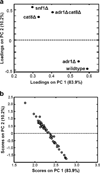Toward a global analysis of metabolites in regulatory mutants of yeast
- PMID: 21416166
- PMCID: PMC3708646
- DOI: 10.1007/s00216-011-4800-2
Toward a global analysis of metabolites in regulatory mutants of yeast
Abstract
The AMP-activated protein kinase in yeast, Snf1, coordinates expression and activity of numerous intracellular signaling and developmental pathways, including those regulating cellular differentiation, response to stress, meiosis, autophagy, and the diauxic transition. Snf1 phosphorylates metabolic enzymes and transcription factors to change cellular physiology and metabolism. Adr1 and Cat8, transcription factors that activate gene expression after the diauxic transition, are regulated by Snf1; Cat8 through direct phosphorylation and Adr1 by dephosphorylation in a Snf1-dependent manner. Adr1 and Cat8 coordinately regulate numerous genes encoding enzymes of gluconeogenesis, the glyoxylate cycle, β-oxidation of fatty acids, and the utilization of alternative fermentable sugars and nonfermentable substrates. To determine the roles of Adr1, Cat8, and Snf1 in metabolism, two-dimensional gas chromatography coupled to time-of-flight mass spectrometry and liquid chromatography coupled to tandem mass spectrometry were used to identify metabolites whose levels change after the diauxic transition in wild-type-, ADR1-, CAT8-, and SNF1-deficient yeast. A discovery-based approach to data analysis utilized chemometric algorithms to identify, quantify, and compare 63 unique metabolites between wild type, adr1∆, cat8∆, adr1∆cat8∆, and snf1∆ strains. The primary metabolites found to differ were those of gluconeogenesis, the glyoxylate and tricarboxylic acid cycles, and amino acid metabolism. In general, good agreement was observed between the levels of metabolites derived from these pathways and the levels of transcripts from the same strains, suggesting that transcriptional control plays a major role in regulating the levels of metabolites after the diauxic transition.
Figures





Similar articles
-
Multiple pathways are co-regulated by the protein kinase Snf1 and the transcription factors Adr1 and Cat8.J Biol Chem. 2003 Jul 11;278(28):26146-58. doi: 10.1074/jbc.M301981200. Epub 2003 Apr 3. J Biol Chem. 2003. PMID: 12676948
-
Snf1 controls the activity of adr1 through dephosphorylation of Ser230.Genetics. 2009 Jul;182(3):735-45. doi: 10.1534/genetics.109.103432. Epub 2009 Apr 27. Genetics. 2009. PMID: 19398770 Free PMC article.
-
14-3-3 (Bmh) proteins regulate combinatorial transcription following RNA polymerase II recruitment by binding at Adr1-dependent promoters in Saccharomyces cerevisiae.Mol Cell Biol. 2013 Feb;33(4):712-24. doi: 10.1128/MCB.01226-12. Epub 2012 Dec 3. Mol Cell Biol. 2013. PMID: 23207903 Free PMC article.
-
Transcriptional regulation of nonfermentable carbon utilization in budding yeast.FEMS Yeast Res. 2010 Feb;10(1):2-13. doi: 10.1111/j.1567-1364.2009.00555.x. Epub 2009 Jul 18. FEMS Yeast Res. 2010. PMID: 19686338 Free PMC article. Review.
-
Transcriptional control of nonfermentative metabolism in the yeast Saccharomyces cerevisiae.Curr Genet. 2003 Jun;43(3):139-60. doi: 10.1007/s00294-003-0381-8. Epub 2003 Apr 25. Curr Genet. 2003. PMID: 12715202 Review.
Cited by
-
Bacterial volatile discovery using solid phase microextraction and comprehensive two-dimensional gas chromatography-time-of-flight mass spectrometry.J Chromatogr B Analyt Technol Biomed Life Sci. 2012 Jul 15;901:41-6. doi: 10.1016/j.jchromb.2012.05.038. Epub 2012 Jun 7. J Chromatogr B Analyt Technol Biomed Life Sci. 2012. PMID: 22727751 Free PMC article.
-
Nutritional control of growth and development in yeast.Genetics. 2012 Sep;192(1):73-105. doi: 10.1534/genetics.111.135731. Genetics. 2012. PMID: 22964838 Free PMC article. Review.
-
Sample preparation methodology for mouse heart metabolomics using comprehensive two-dimensional gas chromatography coupled with time-of-flight mass spectrometry.Talanta. 2013 Apr 15;108:123-30. doi: 10.1016/j.talanta.2013.03.005. Epub 2013 Mar 13. Talanta. 2013. PMID: 23601879 Free PMC article.
-
Improving the quality of biomarker candidates in untargeted metabolomics via peak table-based alignment of comprehensive two-dimensional gas chromatography-mass spectrometry data.J Chromatogr A. 2015 May 15;1394:111-7. doi: 10.1016/j.chroma.2015.03.001. Epub 2015 Mar 7. J Chromatogr A. 2015. PMID: 25857541 Free PMC article.
-
Automating and Extending Comprehensive Two-Dimensional Gas Chromatography Data Processing by Interfacing Open-Source and Commercial Software.Anal Chem. 2020 Oct 20;92(20):13953-13960. doi: 10.1021/acs.analchem.0c02844. Epub 2020 Oct 9. Anal Chem. 2020. PMID: 32985172 Free PMC article.
References
-
- Goodacre R, Vaidyanathan S, Dunn WB, Harrigan GG, Kell DB. Metabolomics by numbers: acquiring and understanding global metabolite data. Trends Biotechnol. 2004;22(5):245–252. - PubMed
-
- Hollywood K, Brison DR, Goodacre R. Metabolomics: current technologies and future trends. Proteomics. 2006;6:4716–4723. - PubMed
-
- Weckwerth W, Morgenthal K. Metabolomics: from pattern recognition to biological interpretation. Drug Discov Today. 2005;10(22):1551–1558. - PubMed
-
- Dunn WB, Bailey NJ, Johnson HE. Measuring the metabolome: current analytical technologies. Analyst. 2005;130:606–625. - PubMed
-
- Dunn WB, Ellis DI. Metabolomics: current analytical platforms and methodologies. Trends Anal Chem. 2005;24(4):285–294.
Publication types
MeSH terms
Substances
Grants and funding
LinkOut - more resources
Full Text Sources
Molecular Biology Databases

